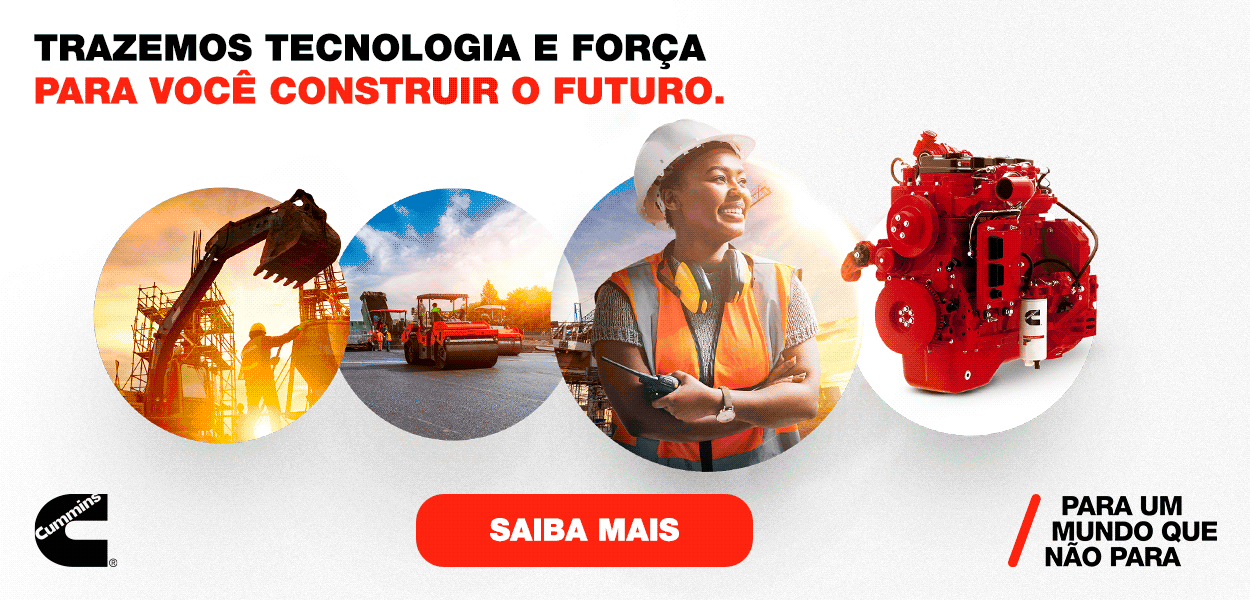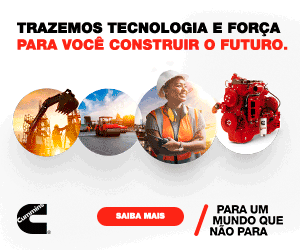The new generation of steering systems
Technologies for truck steering systems advance quickly the world over in this industry which is already preparing the introduction of an unprecedented system with a fully electric concept
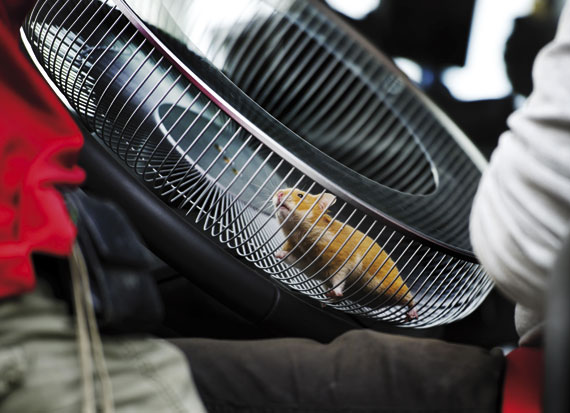
Imagine a tiny 175-gram hamster inside a wire cage attached to the steering wheel of a 15-ton truck. Even though it might seem like something insane and pointless, continue imagining that - by moving a carrot around - an operator will attract the animal, making it scurry to the right or to the left. With that hamster always at the wheel “driving”, increase the degree of complexity of the situation by shifting into first gear and starting the truck. Now put this outlandish set of circumstances together in an open pit mine with paths of extremely irregular soil, narrow lanes and chasms all over.
Well, you can stop just imagining because it all really happened. In fact, the experiment took place recently in Spain; the hamster’s name is Charlie; and this was the unique, unheard-of way that Volvo Trucks found to demonstrate the ease that an electric steering system can provide for heavy trucks (watch the video on YouTube by accessing the link at the end of this story). “The achievement of this hamster is part of one of many spectacular tests involving the new models of our trucks,” says Claes Nilsson, President of Volvo Trucks worldwide.
UPGRADE
The first steering system in the world to utilize electric-steering concepts for trucks, the feature equips the FMX line - for off-road applications - manufactured by the Swedish multinational. Christened by the company “Dynamic Steering”, Volvo's solution is already considered the second evolution of steering systems for trucks. The first step forward, as in passenger cars, was the upgraded from mechanical to hydraulic power steering. But now, the future points to electric power-steering technology as a new industry standard.
Technically, the novelty is a cross between conventional hydraulic power steering and an electric motor that is controlled electronically and coupled to the steering shaft. “At low speeds, even trucks that are fully-loaded have steering that is so light that you can maneuver them with just one finger,” explains Jan-Inge Svensson, an engineer who worked on developing the software that controls the system. “When you travel on roads, this dynamic system provides incomparable directional stability.”
In this technology, the job of the electric motor is precisely to increase steering sensitivity at each moment of the vehicle’s operation. Therefore, the system’s sensors help the driver to drive straight, automatically reducing the interference of the road surface which can destabilize the steering wheel under certain circumstances.
PLATFORM
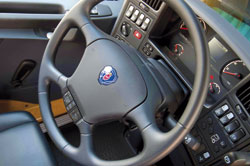 The electric steering system, however, is not yet available for the Brazilian market. Like Volvo, other vehicle manufacturers such as Scania, MAN and Iveco remain focused on hydraulic power-steering systems. “Actually, mechanical steering is too heavy for the driver and, therefore, it’s been some time now that it is no longer used in trucks,” says André Favareto, the person responsible for the technical assistance area for Scania in Brazil.
The electric steering system, however, is not yet available for the Brazilian market. Like Volvo, other vehicle manufacturers such as Scania, MAN and Iveco remain focused on hydraulic power-steering systems. “Actually, mechanical steering is too heavy for the driver and, therefore, it’s been some time now that it is no longer used in trucks,” says André Favareto, the person responsible for the technical assistance area for Scania in Brazil.
Hydraulic steering or power steering, on the other hand, allows manufacturers to reduce the diameter of the steering wheel, thereby providing greater comfort for the driver and ‘relief’ for the hydraulic system itself. “This system is composed of a hydraulic pump, reservoir, piping and hydraulic system control valve,” the specialist explains.
Marcello Motta, director of product development for Iveco, explains that a steering system is itself conceptually mechanical and its activation, in order to relieve strain and effort upon the driver, is what can have a hydraulic or electric concept. “Thus, the hydraulic pump is connected to a hydraulic motor which, in turn, uses pressure transmitted by the hydraulic fluid to operate the mechanical part of the system and thus reduce the force that has to be used by the driver,” he underscores.
Motta reasons that electric motors and hydraulic motors have the same role and that, in both cases, there are situations in which the motor is attached to the steering column and others in which it is part of the steering box. “The main advantage that an electric system can provide is lower fuel consumption,” he says. “And the drawback is that, presently, this technology is still very limited to luxury passenger vehicles.”
John Herrmann, product marketing supervisor at MAN, points out that lower fuel consumption is something natural in electric systems since they are driven by power from the vehicle’s battery (which is charged by the alternator), while the hydraulic assembly - consisting of a motor and pump - is powered directly by the truck’s diesel engine.
FACILITY
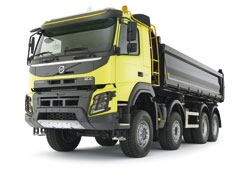 Whether electric or hydraulic, new steering systems are intended to facilitate driving in any off-road environment, including construction job sites and at ore mines. In such cases, Herrmann points out that the suspension and steering systems do not differ much in on-highway and off-road trucks. “What we find is a particular configuration of geometry in which angles are adjusted for off-road environments,” he describes. Thus, the angle that is most affected is that of the caster which is responsible for the vehicle’s self-centering torque. “The angle should be increased in off-road trucks so that it doesn’t demand unwarranted driver effort at the wheel,” said Herrmann.
Whether electric or hydraulic, new steering systems are intended to facilitate driving in any off-road environment, including construction job sites and at ore mines. In such cases, Herrmann points out that the suspension and steering systems do not differ much in on-highway and off-road trucks. “What we find is a particular configuration of geometry in which angles are adjusted for off-road environments,” he describes. Thus, the angle that is most affected is that of the caster which is responsible for the vehicle’s self-centering torque. “The angle should be increased in off-road trucks so that it doesn’t demand unwarranted driver effort at the wheel,” said Herrmann.
Another particularity - which calls for the application of higher caster angles in models of trucks to be used for operations in mines or construction sites - is the deformation of the springs during braking; a characteristic of the suspension system technically known as ‘spring wind-up’. “If this attribute is not adjusted for off-road environments, the operation can cause ‘pulling’ or turning of the steering wheel during braking and, consequently, loss of the vehicle’s balance,” says the specialist at MAN, reminding us that none of the other angles associated with the steering and suspension systems - such as camber, convergence, wheel alignment etc.. - require significant changes.
Herrmann further stresses that the main difference of highway trucks intended for the off-road market lies mainly in the robustness of the system as a whole, including its housing, terminals, drag link and its other components.
Technologies for equipment
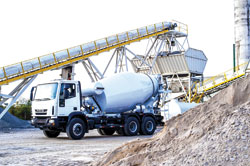 Advances in hydraulics also include steering systems for off-road equipment. Among hydrostatic, hydro-mechanical and electrohydraulic options, the most advanced today are those that allow remote operation with the use of global positioning technology (GPS).
Advances in hydraulics also include steering systems for off-road equipment. Among hydrostatic, hydro-mechanical and electrohydraulic options, the most advanced today are those that allow remote operation with the use of global positioning technology (GPS).
This is the case of electrohydraulic steering manufactured by Danfoss Power Solutions, formerly Sauer Danfoss. In combination with GPS, the solution is used in machines such as tractors, sprayers and harvesters, consisting basically of a steering controller attached to the machine. Via an antenna installed on the roof of the equipment, the component receives positional information from a satellite and directs the information to electronically controlled valves coupled to the hydrostatic steering. The command module then activates the hydraulic cylinders which, in turn, determine the direction of the equipment’s wheels.
Optionally, this system can be complemented by other technologies such as a torque amplifier with priority valves - a solution that allows steering fluid (oil) to be redirected to other machine components. Another on-board technology is the flow amplifier. In this case the action is reversed with more fluid being directed to the hydraulic steering cylinder. Obviously, that means a loss of torque for the equipment, but it also increases the efficiency of steering decreasing the number of turns of the steering wheel required to maneuver the equipment.
Danfoss Power Solutions General Manager Dirnei Antonio Datti points out that some GPS-based steering technologies are older and already well known in the sector, but they are much less efficient. “These are systems where the GPS signal is sent to a sort of independent steering assembly which acts directly upon the steering wheel,” he explains. “The difference in our technology is that the signal is sent to a hydrostatic steering assembly making its operation very similar to that of manual steering, but with the benefits of productivity and precision that GPS provides.”
Watch the video of Charlie the hamster steering a Volvo truck at:
www.youtube.com/watch?v=7N87uxyDQT0&feature=youtu.be
Iveco launches a 6x4 for cement mixers
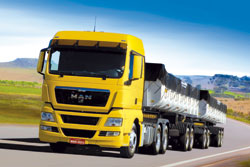 Newly released, Iveco’s Tector Concreto - a vocational model - joins the range of semi-heavy trucks with its 26 tons of total gross weight. With the launch, Iveco seeks to expand its market share in the segment; a promising niche that moves some 9,000 units per year. Of this total, says the manufacturer, the share of trucks equipped with mixer drums (concrete mixing trucks) is 25%.
Newly released, Iveco’s Tector Concreto - a vocational model - joins the range of semi-heavy trucks with its 26 tons of total gross weight. With the launch, Iveco seeks to expand its market share in the segment; a promising niche that moves some 9,000 units per year. Of this total, says the manufacturer, the share of trucks equipped with mixer drums (concrete mixing trucks) is 25%.
An upgrade of the company’s Model 260E28 [photo], the Tector Concreto was designed based on data from studies conducted with end-users - such as the Cortesia and Supermix ready-mixed concrete companies - and has a few particularities, such as a 400 liter aluminum fuel tank, which gives the vehicle greater autonomy. The model is equipped with a 280 horsepower engine providing 950 Nm of torque and is available in two options of wheelbases (3,690 mm and 4,815 mm). The brakes feature automatic adjustment which reduces downtime for maintenance and the exhaust pipe is vertical, preventing the driver and other workers alongside the mixer drum from having direct contact with the particulate matter emissions.
Sources:
Danfoss Power Solutions: http://powersolutions.danfoss.com/
Iveco: www.iveco.com.br
MAN Latin America: www.man-la.com
Scania: www.scania.com.br
Volvo Trucks: www.volvotrucks.com

Av. Francisco Matarazzo, 404 Cj. 701/703 Água Branca - CEP 05001-000 São Paulo/SP
Telefone (11) 3662-4159
© Sobratema. A reprodução do conteúdo total ou parcial é autorizada, desde que citada a fonte. Política de privacidade











